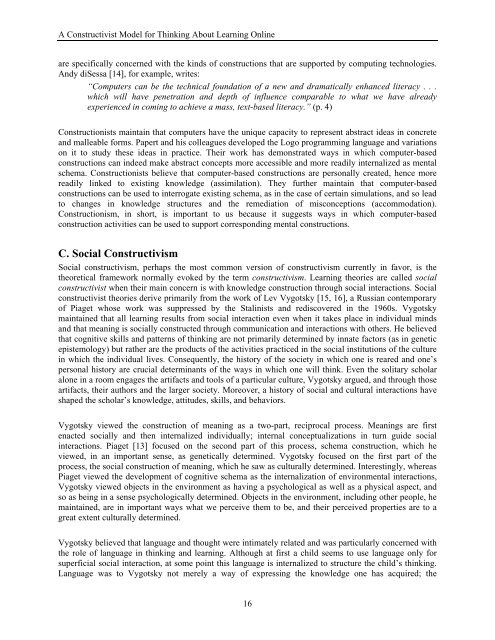Elements of Quality Online Education cation
Elements of Quality Online Education cation
Elements of Quality Online Education cation
You also want an ePaper? Increase the reach of your titles
YUMPU automatically turns print PDFs into web optimized ePapers that Google loves.
A Constructivist Model for Thinking About Learning <strong>Online</strong>are specifically concerned with the kinds <strong>of</strong> constructions that are supported by computing technologies.Andy diSessa [14], for example, writes:“Computers can be the technical foundation <strong>of</strong> a new and dramatically enhanced literacy . . .which will have penetration and depth <strong>of</strong> influence comparable to what we have alreadyexperienced in coming to achieve a mass, text-based literacy.” (p. 4)Constructionists maintain that computers have the unique capacity to represent abstract ideas in concreteand malleable forms. Papert and his colleagues developed the Logo programming language and variationson it to study these ideas in practice. Their work has demonstrated ways in which computer-basedconstructions can indeed make abstract concepts more accessible and more readily internalized as mentalschema. Constructionists believe that computer-based constructions are personally created, hence morereadily linked to existing knowledge (assimilation). They further maintain that computer-basedconstructions can be used to interrogate existing schema, as in the case <strong>of</strong> certain simulations, and so leadto changes in knowledge structures and the remediation <strong>of</strong> misconceptions (accommodation).Constructionism, in short, is important to us because it suggests ways in which computer-basedconstruction activities can be used to support corresponding mental constructions.C. Social ConstructivismSocial constructivism, perhaps the most common version <strong>of</strong> constructivism currently in favor, is thetheoretical framework normally evoked by the term constructivism. Learning theories are called socialconstructivist when their main concern is with knowledge construction through social interactions. Socialconstructivist theories derive primarily from the work <strong>of</strong> Lev Vygotsky [15, 16], a Russian contemporary<strong>of</strong> Piaget whose work was suppressed by the Stalinists and rediscovered in the 1960s. Vygotskymaintained that all learning results from social interaction even when it takes place in individual mindsand that meaning is socially constructed through communi<strong>cation</strong> and interactions with others. He believedthat cognitive skills and patterns <strong>of</strong> thinking are not primarily determined by innate factors (as in geneticepistemology) but rather are the products <strong>of</strong> the activities practiced in the social institutions <strong>of</strong> the culturein which the individual lives. Consequently, the history <strong>of</strong> the society in which one is reared and one’spersonal history are crucial determinants <strong>of</strong> the ways in which one will think. Even the solitary scholaralone in a room engages the artifacts and tools <strong>of</strong> a particular culture, Vygotsky argued, and through thoseartifacts, their authors and the larger society. Moreover, a history <strong>of</strong> social and cultural interactions haveshaped the scholar’s knowledge, attitudes, skills, and behaviors.Vygotsky viewed the construction <strong>of</strong> meaning as a two-part, reciprocal process. Meanings are firstenacted socially and then internalized individually; internal conceptualizations in turn guide socialinteractions. Piaget [13] focused on the second part <strong>of</strong> this process, schema construction, which heviewed, in an important sense, as genetically determined. Vygotsky focused on the first part <strong>of</strong> theprocess, the social construction <strong>of</strong> meaning, which he saw as culturally determined. Interestingly, whereasPiaget viewed the development <strong>of</strong> cognitive schema as the internalization <strong>of</strong> environmental interactions,Vygotsky viewed objects in the environment as having a psychological as well as a physical aspect, andso as being in a sense psychologically determined. Objects in the environment, including other people, hemaintained, are in important ways what we perceive them to be, and their perceived properties are to agreat extent culturally determined.Vygotsky believed that language and thought were intimately related and was particularly concerned withthe role <strong>of</strong> language in thinking and learning. Although at first a child seems to use language only forsuperficial social interaction, at some point this language is internalized to structure the child’s thinking.Language was to Vygotsky not merely a way <strong>of</strong> expressing the knowledge one has acquired; the16
















